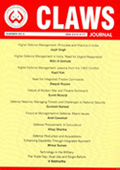| #774 | 1113 | February 02, 2012 | By Brig Gurmeet Kanwal | |||||
|
Contrary to Deng Xiaoping’s advice to his successors to ‘hide your capacitiesand bide your time,’ China has been rather assertive in recent years inestablishing itself as a world power. Chinese belligerence in dealing with itsneighbours and, more particularly, in staking its claim to disputed islands inthe South China Sea, has sent alarm bells ring across the Asia-Pacific region.The world is no longer sure whether China will continue to behave responsiblywhile discharging its international obligations and conducting its foreignaffairs. A direct consequence of perceived Chinese assertiveness has been the newstrategic guidance for the United States announced by President Barack Obamaearly in the New Year. Announced during a rare visit to the Pentagon on January7, 2012, the new strategy is titled ‘Sustaining US global leadership:Priorities for 21st century defence.’ As the US winds down its wars in Afghanistan and Iraq, it is re-orientating itspriorities towards the new challenges emanating from the Asia-Pacific region.Obama said the strategy review centred on creating the future military thecountry will need after the ‘long wars of the last decade are over.’ The newstrategy seeks to find a balance between fiscal prudence and the challenge of passingthrough a ‘moment of transition’ in global affairs. Obama also said “Our military will be leaner, but the world must know theUnited States is going to maintain our military superiority with armed forcesthat are agile, flexible and ready for the full range of contingencies andthreats.” In military terms, the strategic guidance dilutes the currentrequirement for the US armed forces to be capable of fighting and winning warsin two major theatres simultaneously. The new strategy states significantly that the US will “maintain its ability toproject power in areas in which our access and freedom to operate arechallenged.” This postulation probably refers to China’s ‘anti-access andarea-denial’ (A2/AD) strategy. China’s much touted A2/AD strategy relies onanti-ship ballistic missiles such as the purpose-built Dong Feng 21-D,conventionally armed attack submarines, anti-ship mines and swarms of smallvessels, to attack US aircraft carriers that approach China’s coast in a war,for example to come to the aid of Taiwan during a future Chinese operation toliberate Taiwan. Another critical aspect of the new strategic guidance is the reduction in forcelevels envisioned by President Obama. He announced spending cuts of $487billion over the next ten years. However, this amount is a small percentage ofthe current annual budget of $650 billion of the US Department of Defence. Thisamounts to 45 per cent of the world’s total annual defence expenditure. Forward presence While the president refrained from clearly naming China as a threat, thestrategy document said, “Over the long-term, China's emergence as aregional power will have the potential to affect the US economy and oursecurity in a variety of ways.” The new US strategy identifies the target areafor future conventional conflict as “the arc extending from the Western Pacificand East Asia into the Indian Ocean region and South Asia.” The strategy expects and banks on major military support from partner countrieslike India, while seeking to be their “security partner of choice.”Significantly, the strategy document explicitly views India as a key strategicpartner in the US quest to maintain peace and stability in the Asia-Pacificregion: "The United States is investing in a long-term strategicpartnership with India to support its ability to serve as a regional economicanchor and provider of security in the broader Indian Ocean region.” While the possibility of a common future threat from China has not beenexplicitly spelt out, it is implicit in the broad underpinnings of the new USstrategy. There is apprehension in both India and the US that China may notbehave responsibly in future, or that it might implode due to its internalcontradictions. Though the probability of both these occurrences is viewed as extremely low, itis felt that should either of them come to pass, both India and the US willneed strong strategic partners to manage the crisis. As large democracies withan ever increasing mutuality of interests it is natural for both to rely oneach other. Growing political and economic relations with the US do not necessarily have tolead to a military alliance. India must adopt a hedging strategy in order to beable to deal with the possibility of errant Chinese behaviour in future afterChina has completed its military modernisation. India should continue to forgea strong strategic partnership with the US while simultaneously pursuing goodrelations with China. Should a future Indian government decide to join hands with the US militarily,it must carefully guard against being sucked into a new arms race in its questto provide the support that the new US strategy demands from partner countries.India must learn the lessons of the Soviet collapse at the end of the Cold Warand avoid such an economically crippling venture. Pragmatic realism is theanswer. The writer is director, Centre for Land Warfare Studies, New Delhi Courtesy: Deccan Herald, 26 January 2012 http://www.deccanherald.com/content/222303/taming-dragon.html | ||||||||
| ||||||||


